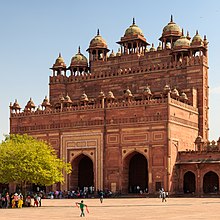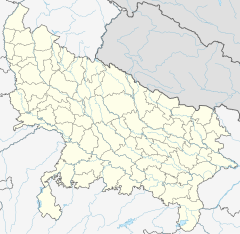Jama Mosque, Fatehpur Sikri
| Jama Mosque, Fatehpur Sikri | |
|---|---|
 | |
| Religion | |
| Affiliation | Islam |
| Location | |
| Geographic coordinates | 27°05′42″N 77°39′46″E / 27.09500°N 77.66278°E |
| Architecture | |
| Type | Congregational mosque |
| Style | Indo-Islamic, Mughal |
| Founder | Akbar |
| Specifications | |
| Length | 165.20 m |
| Width | 133.60 m |
| Dome(s) | 3 |
| Materials | Red sandstone |
The Jama Masjid is a 16th-century
Notable monuments in the mosque complex include the Buland Darwaza, which acts as the mosque's southern gate, and the Tomb of Salim Chishti, a saint in whose honour the mosque was constructed.
History
Akbar commissioned the Jama Masjid as part of his new capital city of Fatehpur Sikri. The structure was one of the first sites constructed in the city, and was completed sometime between 1571 and 1574, according to its own inscriptions.
The mosque played a part in Akbar's religious designs. In 1579, he delivered the
The Jama Masjid at Fatehpur Sikri remained a "symbol of Mughal heritage and pride" after Akbar's rule.[5] The mosque was heavily admired by Akbar's son and successor Jahangir, who called it one of his father's greatest architectural achievements. Jahangir discussed the mosque complex at length with his son Khurram during a stay at Fatehpur Sikri in 1619.[6][3] Khurram went on to become Mughal Emperor Shah Jahan, and cited this mosque as the model for his own Jama Masjid at Delhi.[5]
Architecture

The Jama Masjid is situated on the highest point of the rocky ridge on which the Fatehpur Sikri site is located.
At the time of its construction, the mosque was the largest in
Gates
The mosque complex is entered via three gates.
Courtyard
The
Towards the northern side of the courtyard are the Tomb of Salim Chishti, the tomb of Islam Khan, and those of several other members of the Chishti family. Salim Chishti's mausoleum is contrasted from the red sandstone of the Jama Masjid complex by its wholesale use of makrana marble.[10] Underground water reservoirs lie beneath the courtyard.[7]
Prayer Hall
The rectangular prayer hall (dimensions 89 m by 20 m) lies on the western end of the courtyard, facing
See also
- Islam in India
- Jodha Bai Mahal
- Taj Mahal
- Tomb of Salim Chishti
- Ibadat Khana
- Naubat Khana
- Buland Darwaza
References
- ^ ISSN 0266-6030.
- ^ a b Asher 1992, p. 53-54.
- ^ a b c d Alfieri 2000, p. 219.
- ^ a b Asher 1992, p. 55.
- ^ a b Asher 1992, p. 202.
- ^ Asher 1992, p. 110.
- ^ a b c d Asher 1992, p. 52.
- ^ a b c d e f "Jami' Masjid, Fatehpur Sikri, India". ArchNet.
- ^ Asher 1992, p. 54.
- ^ a b c d Alfieri 2000, p. 220.
- ^ Asher 1992, p. 53.
- ^ Alfieri 2000, p. 219-220.
Bibliography
- Asher, Catherine B. (1992), Architecture of Mughal India, ISBN 9780521267281
- Alfieri, Bianca Maria (2000), Islamic Architecture of the Indian Subcontinent, ISBN 9781856691895


